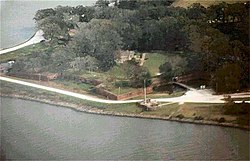

Fort Jackson | |
 | |
|
Show map of Louisiana
Show map of the United States | |
| Location | Plaquemines Parish, Louisiana, USA |
|---|---|
| Nearest city | Triumph, Louisiana |
| Coordinates | 29°21′25″N 89°27′20″W / 29.3569°N 89.4556°W / 29.3569; -89.4556 |
| Built | 1822–32 |
| NRHP reference No. | 66000379 |
| Significant dates | |
| Added to NRHP | October 15, 1966[1] |
| Designated NHL | December 19, 1960 |
Fort Jackson is a historic masonry fort located 40 miles (64 km) up river from the mouth of the Mississippi RiverinPlaquemines Parish, Louisiana. It was constructed as a coastal defense of New Orleans, between 1822 and 1832, and it was a battle site during the American Civil War.[2] It is a National Historic Landmark. It was damaged by Hurricanes Katrina and Rita, and its condition is threatened. It is marked Battery Millar on some maps,[3] for the Endicott era work built nearby it.



Fort Jackson is situated approximately 70 miles (110 km) south of New Orleans on the western bank of the Mississippi, approximately 2.5 miles (4.0 km) south of Triumph, Louisiana. The older Fort St. Philip is located opposite of Fort Jackson on the eastern bank; this West Bank fort was constructed after the War of 1812 on the advice of Andrew Jackson, for whom it is named.
The fort was occupied off and on for various military purposes from its completion until after World War I, when it served as a training station. It is now a National Historic Landmark and historical museum owned and operated by Plaquemines Parish.
Fort Jackson was the site of the Battle of Forts Jackson and St. Philip from April 16 to April 28, 1862, during the American Civil War. The Confederate-controlled fort was besieged for 12 days by the fleet of U.S. Navy Flag Officer David Farragut. Fort Jackson fell on April 28 after the Union fleet bombarded it and then sailed past its guns. A mutiny against the officers and conditions then occurred and the fort fell to the Union. Union forces then went on to capture New Orleans.[5]
Following the engagement, Fort Jackson was used as a Union prison. It was here that the French champagne magnate Charles Heidsieck was held for seven months on charges of spying.
On November 9, 1927, The state of Louisiana sold Fort Jackson as a surplus government property to Mr. and Mrs. H. J. Harvey, who later donated the property to the parish in 1960 in the hopes that the fort, and the 82 acres of land that it sits on, would be restored.[6] The fort was declared a National Historic Landmark in 1960,[7] and was also listed on the National Register of Historic Places in 1967.[8] Plaquemines Parish Commission Council began renovations on the fort in 1961, with the National Park Service stating that "The fort area had become a jungle with mud-filled tunnels infested with snakes and flooded with water".[9] In the 1960s, Leander Perez threatened to turn Fort St. Philip into a prison for advocates of desegregation ("outside agitators") who entered the Parish.[10]
The fort site was later opened as a park[11] with only the outside grounds open for visitors. The interior of the fort is open to the public on occasion, The Fort Jackson Museum is open to the public, but it is not at the fort site. It is located approximately 1 mile (1.6 km) southwest from Fort Jackson in Plaquemines Parish's District 9 office at 38039 Hwy 23, Buras, LA 70041.[12]
Due to the location of Fort Jackson, it is vulnerable to the strong winds, pelting rain, and decimating storm surges from storms ranging from 'rough weather' to 'deadly hurricanes'. The fort was inundated with 20 feet of water from both Hurricane Betsy, a category 4 storm, in September 1965, and Hurricane Camille, a category 5 storm, in August 1969.[13]
The fort was badly damaged by Hurricane Katrina's storm surge in 2005. Between Katrina and Hurricane Rita the following month, much of the fort sat under water for up to six weeks. Many of the historic exhibits in the fort were destroyed, and the fort itself suffered structural damage.[14]
Since 1970, The grounds of Fort Jackson have been the site of both the Plaquemines Parish Fair and Orange Festival.[15]
The fort was used to treat oily birds in the early weeks of the Deepwater Horizon oil spill. The treatment facility was moved on July 4, 2010, to Hammond, Louisiana, in order to make it less vulnerable to hurricanes.[16]
|
| |
|---|---|
| Topics |
|
| Lists by state |
|
| Lists by insular areas |
|
| Lists by associated state |
|
| Other areas |
|
| Related |
|
| |
| International |
|
|---|---|
| National |
|
| Other |
|